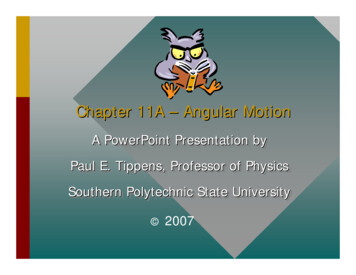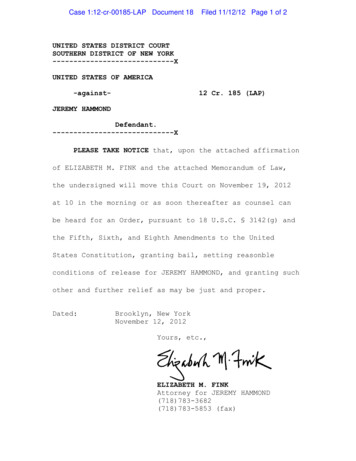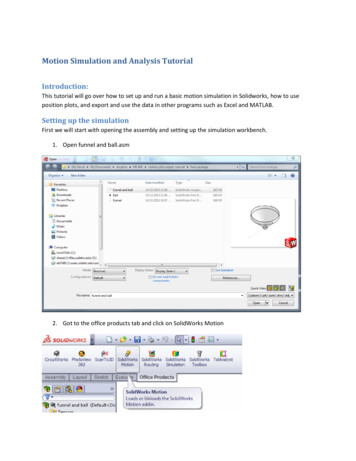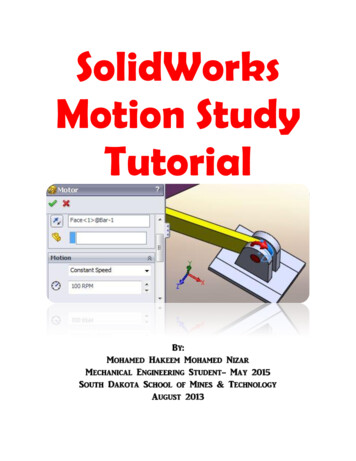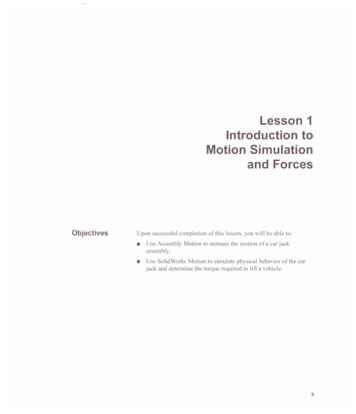
Transcription
Physics 235Chapter 10Chapter 10Motion in a Non-Inertial Reference FrameThe laws of physics are only valid in inertial reference frames. However, it is not always easyto express the motion of interest in an inertial reference frame. Consider for example the motionof a book laying on top of a table. In a reference frame that is fixed with respect to the Earth, themotion is simple: if the book is at rest, it will remain at rest (here we assume that the surface of thetable is horizontal). However, we do know that the earth frame is not an inertial frame. In orderto describe the motion of the book in an inertial frame, we need to take into account the rotationof the Earth around its axis, the rotation of the Earth around the sun, the rotation of our solar systemaround the center of our galaxy, etc. etc. The motion of the book will all of a sudden be a lot morecomplicated!For many experiments, the effect of the Earth not being an inertial reference frame is too smallto be observed. Other effects, such as the tides, can only be explained if we take into considerationthe non-inertial nature of the reference frame of the Earth and apply the laws of physics in aninertial frame.Rotating Coordinate SystemsConsider the two coordinate systems shown in Figure 1. The non-primed coordinates are thecoordinates in the rotating frame, and the primed coordinates are the coordinates in the fixedcoordinate system.Figure 1. Fixed (primed) and rotating (non-primed) coordinate systems. The vector R specifiesthe origin of the rotating coordinate system in the fixed coordinate system.Consider the motion of a point P. In the fixed coordinate system, the position of P is specifiedby the position vector r' and in the rotating coordinate system, its position is specified by theposition vector r. As can be seen from Figure 1, these two vectors are related:- 1 -
Physics 235Chapter 10r' r RConsider what happens when the rotating coordinate system rotates by an infinitesimal angle dq.If point P is at rest in the rotating coordinate system, we will see the position of P in our fixedcoordinate system change:( dr ) fixed dθ rIf the rotation occurs during a period dt, we can rewrite the previous equation asdθ dr r ω r dt fixed dtTo derive this relation we have assumed that point P remains are test in the rotating coordinatesystem. If point P is moving with respect to the rotating coordinate system, we need to add thiscontribution to the expression of the velocity of P in the fixed coordinate system: dr dr ω r dt fixed dt rotatingThis relation is valid for any vector, not just the position vector. If instead of the position vectorwe use the angular velocity vector we find that dω dω dω ω ω dt rotatingdt fixeddt rotatingThis relation shows that the angular acceleration is the same in both reference frames.In order to determine the velocity of point P in the fixed coordinate frame in terms of thevelocity of point P in the rotating coordinate system, we have to go back to the correlation betweenthe position vectors shown in Figure 1. By differentiating the vectors with respect to time weobtain the following relation: dr ' dR dr dt dt fixed dt fixedfixedUsing our expression for the velocity of P in the fixed coordinate system we find that dr ' dR dr ω r dt dt fixed dt rotatingfixed- 2 -
Physics 235Chapter 10This equation can also be rewritten as dr ' dR dr vf ω r V vr ω r dt fixed dt fixed dt rotatingwhere dr ' vf velocit y of P in fixed frame dt fixed dR V linear velocity of the origin of the rotating frame dt fixed dr vr velocit y of P in rotating frame dt rotatingω r velocity of P due to the rotation of the axes"Newton's Law" in Rotating Reference FramesConsider the situation in which an external force F is acting on P. Only in the fixed referenceframe can we use Newton's second law to determine the corresponding acceleration of P: dv Faf f dt fixed mAnother expression for the acceleration of P can be obtained by differentiating the velocity-relationobtained in the previous section with respect to time:af dv dv dV dω dr f r r ω dt fixed dt fixed dt fixed dt fixed dt fixed dv dω dr dV r ω v r ω ω r r dtdt dt fixed dt rotating fixedrotating dv dV r 2ω vr ω! r ω {ω r } dt fixed dt rotating- 3 -
Physics 235Chapter 10An observer in the rotating reference frame will observe an acceleration dv ar dt rotatingThis acceleration is certainly not equal to F/m, but the previous relations can be used to expressthe acceleration in the rotating reference frame in terms of the acceleration in the fixed referenceframe: dV ar a f 2ω vr ω! r ω {ω r } dt fixedThis relation immediately shows what has been repeated already many times: the acceleration ofan object at P will be the same in two reference frames, only if one frame does not rotate withrespect to the other frame (that is w 0 rad/s and dw/dt 0 rad/s2) and if the frames do notaccelerate with respect to the other frame.In order to explore the implication of the relation between the acceleration of P in the rotatingand in the fixed coordinate frames, we assume for the moment that the origin of the rotatingreference frame is not accelerating with respect to the origin of the fixed reference frame (dV/dt 0), and that the axis of the rotating reference frame are rotating with a constant angular velocity(dw/dt 0 rad/s2). Under these assumptions, we find that the acceleration of P in the rotatingreference frame is equal toar a f 2ω vr ω {ω r }The second and the third terms on the right-hand side are non-inertial terms that are introduced tocorrect the real force F in order to be able to use Newton-like laws in the rotating frame:Feff ma f 2mω vr mω {ω r }Using this effective force, an observer in the rotating frame will be able to determine theacceleration in the rotating frame by dividing this effective force by the mass of the object.The second term on the right-hand side of the expression of the effective force is called theCoriolis force, and the last term on the right-hand side is called the centripetal force. Both ofthese forces are however not real forces; they are introduced in order to be able to use an equationsimilar to Newton's second law in non-inertial reference frames. When we try to describe an objecton the surface of the earth, we need to take the effects of these artificial forces into consideration.In the next two sections we will focus on these two forces in some detail.- 4 -
Physics 235Chapter 10The Centripetal ForceThe surface of the earth is a non-inertial reference frame. The biggest deviation from good"inertial" behavior is due to the rotation of the earth around its axis. In the current discussion wewill thus ignore the motion of the earth around the sun, the motion of the solar system in our inour galaxy, etc. etc.Consider a pendulum at rest in our rotating reference frame, which is at rest with respect to thesurface of the earth. Since the pendulum is at rest in this rotating reference frame, its velocity vrin this frame is zero. The effective force seen by the pendulum is thus equal to{}Feff ma f mω {ω r } m g0 ω {ω r }The direction of g0 in this equation is directly towards the center of the earth, while the directionof the non-inertial correction term is radially outwards (see Figure 2). If the angle between theposition vector r and the rotation axis is equal to q, we find the magnitude of the correction termis equal toω {ω r } ω 2 r sin θFigure 2. Direction of the centripetal correction term.The effect of this correction is that the equilibrium position of the pendulum (the position in whichthe arm of the pendulum is parallel to the direction of the net force) is changed, and the arm of thependulum no longer points towards the center of the earth (see Figure 3). The direction of the- 5 -
Physics 235Chapter 10gravitational acceleration, as measured by an observer in the rotating reference frame, is thus equaltog g0 ω {ω r }The centripetal correction changes both the magnitude of the observed acceleration and itsdirection. The angle between the direction of g0 and the direction of g can be found easily (seeFigure 4): ω2 g sin θ ω 2 Rsin θ Δθ θ α θ atan 0 θ atan1 tan θ g0 cosθg0 Figure 3. Effect of the centripetal term on a pendulum located on the surface of the earth.Figure 4. Direction of net gravitational acceleration.The same result could have been obtained if we had solved this problem in a non-rotatingframe. Consider a simple pendulum of mass m attached a string. There are two forces acting on- 6 -
Physics 235Chapter 10this mass: the tension T in the string and the gravitational force Fg. An observer in the inertialframe will observe that mass m carries out circular motion, with a radius R sinq, and know thusthat there must be a net force acting on it, pointing towards the rotation axis. This force must havea magnitude of2 2π Rsin θ 2 TvFr m m mω 2 Rsin θRsin θRsin θThis force must be generated by the component of the tension and the gravitational force in thisdirection. We must thus require that (see Figure 5):mg0 sin θ T sin α mω 2 Rsin θorT sin α mg0 sin θ mω 2 Rsin θFigure 5. Pendulum in inertial frame.The net force in the direction perpendicular to the plan of rotation must be zero, and we must thusrequire that- 7 -
Physics 235Chapter 10T cos α mg cosθCombining these two equations we obtain the following relation between the angles:tan α 2 ω2 T sin α mg0 sin θ mω Rsin θ tan 1 tan θ T cos αmg0 cosθg0 which is the same results we obtained previously.Coriolis ForceThe Coriolis force is responsible for the deflection of objects moving in a rotating coordinatesystem. The force is proportional to the vector product of the angular velocity vector of the rotatingcoordinate system (as measured by an observer in a fixed coordinate system) and the velocityvector of the object in the rotating coordinate frame:FCoriolis 2m (ω vr )The effect of the Coriolis force on the motion of an object is illustrated in Figure 6. Note that thedeflection depends on the z component of the angular velocity vector, which is perpendicular tothe surface of the earth. The z component reaches a maximum value at the North pole, and is zeroat the equator.Figure 6. Deflection of a moving object as a result of the Coriolis force.As a result of the Coriolis force, air flowing from West to East towards a region of low pressurewill be deflected to the South on the Northern hemisphere. Air approaching the low from the Eastwill be deflected to the North. On the Northern hemisphere we will thus expect that the air isflowing counter clockwise around an area of low pressure; in the same manner we can show thatair flows clockwise around an area of high pressure. A lot about the weather can be understoodon the basis of these observations. See for example the forecast map shown Figure 7. The positionof the high pressure system over Michigan will bring cold air from Canada to Rochester (since the- 8 -
Physics 235Chapter 10circulation around the high is in the clockwise direction). We thus expect the winds to be fromthe North. Once the high passes Rochester, the wind should come from the South, bringing ushigher temperatures. The low in the South of the USA will pull in moisture from the gulf ofMexico and rain and thunder can be expected in the region in front of the low (since this is theregion where moisture of the golf of Mexico will go as a result of the counter-clockwise flowaround the low).Figure 7. Forty-eight hour forecast map for Wednesday November 3, 2004, at 1200 p 0700d485).Example: Problem 10.6A bucket of water is set spinning about its symmetry axis. Determine the shape of the waterin the bucket.Consider a small mass m on the surface of the water. From Eq. (10.25) in our text book we get!! mω! r mω (ω r ) 2mω vFeff F mRfrIn the rotating frame, the mass is at rest; thus- 9 -
Physics 235Chapter 10Feff 0The force F will consist of gravity and the force due to the pressure gradient, which is normal tothe surface in equilibrium. Since!! ω! v 0Rfrwe now have0 mg Fp mω (ω r )where Fp is due to the pressure gradient.Since Feff 0, the sum of the gravitational and centrifugal forces must also be normal to the surface.Thus q q.tan θ ′ tan θ buttan θ ' dzdrThus- 10 -ω 2rg
Physics 235Chapter 10ω2 2z r constant2gUpdated on 11/11/19 9:26 AM.- 11 -
to express the motion of interest in an inertial reference frame. Consider for example the motion of a book laying on top of a table. In a reference frame that is fixed with respect to the Earth, the motion is simple: if the book is at rest, it will remain at rest (here we assume that the surface of the table is horizontal). However, we do know that the earth frame is not an inertial frame. In order


